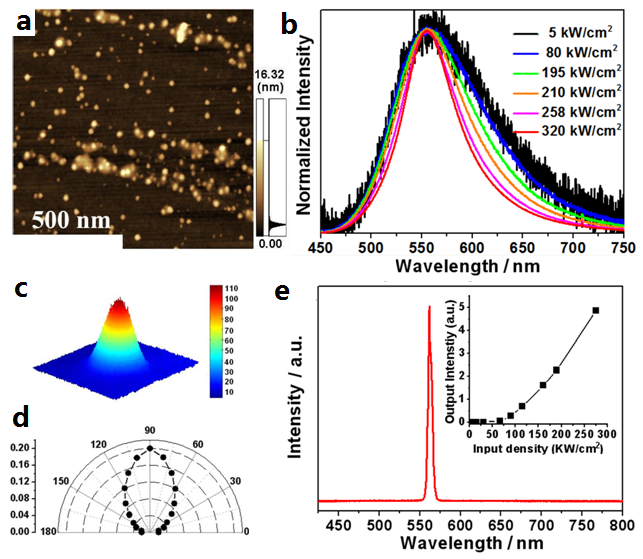
CIOMP Realized Optically Pumped Green Laser Based on Carbon Nanoparticles
Mar 28, 2014 Email"> PrintText Size

Carbon is an important and popular material, which is hardly considered as a member of the “luminescent material familly”. Much attention have been paid on the emerging luminescent carbon-nanoparticles (CNPs) not only because of their superior properties, such as low cost, chemical inertness, lack of optical blinking, low photobleaching, low cytotoxicity, excellent biocompatible and attracting potential applications, but also because the luminescence mechanism of CNPs is still not clearly understood.
Recently, optically pumped green laser based on carbon nanoparticles was realized in Changchun Institute of Optics, Fine Mechanics and Physics (CIOMP). The results demonstrate a new type of low-cost, environmentally friendly, low photobleaching carbon-nanoparticle-based laser materials, which were published in Advanced Functional Materials (DOI: 10.1002/adfm.201303352).
The green emissions of CNPs are usually considered to originate from surface defects. Surface defect states are in general energy dissipative, hard to support lasing emission. After developing a new kind of biocompatible fluorescent ink based on CNPs (Advngew. Chem. Int. Ed. 2012, 51, 12215.) by associate professor QU Songnan’s team in State Key Laboratory of Luminescence and Applications of CIOMP.
QU’s team demonstrate the optical properties of CNPs can be modulated by the dopant-N atom and sp2 C-contents, observe amplified spontaneous emission (ASE), and for the first time achieve green lasing emission from CNPs in a linear long Fabry-Perot cavity. Through analyzing the structures and optical properties of the prepared CNPs, QU’s team pointed the green emission from CNPs arises from electron-hole recombination (intrinsic state emission). The CNPs showed superior photostability compared with organic laser dyes, indicating CNPs could be new type of low-cost, low cytotoxicity and chemical inertness laser materials, and will find potential applications in optoelectronic devices.
In addition, the team for the first time developed ratiometric fluorescent nanosensors based on water soluble CNPs, which can precisely and quantitatively sense temperature, pH values and Fe3+ ions by monitoring the intensity ratios of the dual fluorescence bands (Ib/Ig) under 380 nm excitation. This work promotes the applications of CNPs in bioimaging, medical testing and environmental monitoring, which were published in Nanoscale, 2013, 5, 5514.

Figure 1. (a) AFM image of CNPs, (b) normalized emission spectra of CNPs ethanol aqueous solution (6 mg/mL) under various optically pumped pulse densities, (c) Far-field output beam profile and (d) relationship between the emission intensity and the polarization angle at the excitation power of 274 kW/cm2, (e) emission spectra of the operating CNP-based laser device at the excitation power of 274 kW/cm2 (inset shows the dependence of the spectral peak intensity on the pumping density).
Carbon is an important and popular material, which is hardly considered as a member of the “luminescent material familly”. Much attention have been paid on the emerging luminescent carbon-nanoparticles (CNPs) not only because of their superior properties, such as low cost, chemical inertness, lack of optical blinking, low photobleaching, low cytotoxicity, excellent biocompatible and attracting potential applications, but also because the luminescence mechanism of CNPs is still not clearly understood.
Recently, optically pumped green laser based on carbon nanoparticles was realized in Changchun Institute of Optics, Fine Mechanics and Physics (CIOMP). The results demonstrate a new type of low-cost, environmentally friendly, low photobleaching carbon-nanoparticle-based laser materials, which were published in Advanced Functional Materials (DOI: 10.1002/adfm.201303352).
The green emissions of CNPs are usually considered to originate from surface defects. Surface defect states are in general energy dissipative, hard to support lasing emission. After developing a new kind of biocompatible fluorescent ink based on CNPs (Advngew. Chem. Int. Ed. 2012, 51, 12215.) by associate professor QU Songnan’s team in State Key Laboratory of Luminescence and Applications of CIOMP.
QU’s team demonstrate the optical properties of CNPs can be modulated by the dopant-N atom and sp2 C-contents, observe amplified spontaneous emission (ASE), and for the first time achieve green lasing emission from CNPs in a linear long Fabry-Perot cavity. Through analyzing the structures and optical properties of the prepared CNPs, QU’s team pointed the green emission from CNPs arises from electron-hole recombination (intrinsic state emission). The CNPs showed superior photostability compared with organic laser dyes, indicating CNPs could be new type of low-cost, low cytotoxicity and chemical inertness laser materials, and will find potential applications in optoelectronic devices.
In addition, the team for the first time developed ratiometric fluorescent nanosensors based on water soluble CNPs, which can precisely and quantitatively sense temperature, pH values and Fe3+ ions by monitoring the intensity ratios of the dual fluorescence bands (Ib/Ig) under 380 nm excitation. This work promotes the applications of CNPs in bioimaging, medical testing and environmental monitoring, which were published in Nanoscale, 2013, 5, 5514.

Figure 1. (a) AFM image of CNPs, (b) normalized emission spectra of CNPs ethanol aqueous solution (6 mg/mL) under various optically pumped pulse densities, (c) Far-field output beam profile and (d) relationship between the emission intensity and the polarization angle at the excitation power of 274 kW/cm2, (e) emission spectra of the operating CNP-based laser device at the excitation power of 274 kW/cm2 (inset shows the dependence of the spectral peak intensity on the pumping density).
CAS Institutes
There are 124 Institutions directly under the CAS by the end of 2012, with 104 research institutes, five universities & supporting organizations, 12 management organizations that consist of the headquarters and branches, and three other units. Moreover, there are 25 legal entities affiliated and 22 CAS invested holding enterprisesThere are 124 I...>> more
Contact Us

Chinese Academy of Sciences
Add: 52 Sanlihe Rd., Xicheng District, Beijing, China
Postcode: 100864
Tel: 86-10-68597592 (day) 86-10-68597289 (night)
Fax: 86-10-68511095 (day) 86-10-68512458 (night)
E-mail: cas_en@cas.cn

